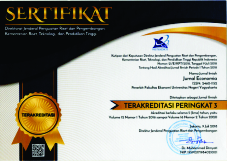Local Government Spending on Social Protection, Security Order, and Crime
Downloads
Abstract: This study aims to analyze the effect of government spending on social protection and security order sectors on crime using police data from 26 police stations in West Java during 2012-2016. The research method used is the fixed effect Pooled EGLS (Cross Section Weights). Also, to test the consistency of the main variables studied, this study features robust First Difference-Generalized Method Moment (FD-GMM) and System-Generalized Method Moment (SYS-GMM). The results showed that the combination of government spending in the security order and social protection sectors had a negative and significant effect on the total amount of crime. These results prove that the government's budget policy can create a positive contribution to reducing crime rates.
Keywords: fixed effect, crime, government spending, social protection, security order
Pengeluaran Pemerintah Sektor Perlindungan Sosial, Ketertiban Keamanan, dan Kriminalitas
Abstrak: Penelitian ini bertujuan untuk melihat menganalisis pengeluaran pemerintah di sektor perlindungan sosial dan ketertiban keamanan terhadap kriminalitas dengan menggunakan data kepolisian dari 26 polres di Jawa Barat selama tahun 2012-2016. Metode penelitian yang digunakan adalah fixed effect Pooled EGLS (Cross Section Weights). Selain itu, untuk menguji konsistensi dari variabel utama yang diteliti, penelitian ini juga dilengkapi robust First Difference-Generalized Method Moment (FD-GMM) dan System- Generalized Method Moment (SYS-GMM). Hasil penelitian menunjukkan bahwa kombinasi pengeluaran pemerintah di sektor ketertiban keamanan dan perlindungan sosial berpengaruh negatif dan signifikan terhadap jumlah total kriminalitas. Hasil tersebut membuktikan bahwa kebijakan anggaran pemerintah mampu memberikan kontribusi positif terhadap penurunan angka kriminalitas.
Kata Kunci: fixed effect, kriminalitas, pengeluaran pemerintah, perlindungan sosial, ketertiban keamanan
Downloads
Arshad, N, Anwar, A, Sarwar, S.(2016). Role of Expenditures and Economic Factors in Determining The Incidence of Crime: Cross Districts Analysis of Punjab. Caspian Journal of Applied Sciences Research, 5(2), pp. 32-40. ISSN: 2251-9114
Atmasasmita, R & Wibowo, K. (2016). Analisis Ekonomi Mikro tentang Hukum Pidana Indonesia. Jakarta : Prenadamedia Group.
Badan Pusat Statistik (BPS). (2014). Statistik Kriminal 2014. Jakarta: BPS
Badan Pusat Statistik (BPS). (2016). Statistik Kriminal 2016. Jakarta: BPS
Becker, G. (1968). Crime and Punishment: An Economic Approach. Journal of Political Economy, 76(2), 169-217. Retrieved from http://www.jstor.org/stable/1830482
Becker, G. (1974). Crime and Punishment: An Economic Approach. Journal of Political Economy, 76(2). NBER. ISBN: 0-87014-263-1
Becsi, Z. (1999). Economic and Crimes in The States. Federal Reserve Bank of Atlanta Economic Review First Quarter.
Buonanno, P & Montolio, D. (2008). Identifying The Socio-Economic and Demographic Determinants of Crime Across Spanish Provinces. International Review of Law and Economics, 28(2008), 89–97. DOI : https://doi.org/10.1016/j.irle.2008.02.005
Chintrakarn, P, Herzer, D & Nunnenkamp, P. (2011). FDI and Income Inequality: Evidence From A Panel of U.S. States. Western Economic Association International. DOI: https://doi.org/10.1111/j.1465-7295.2011.00384.x
Gillbert,K & Sookram, S. (2009). The Socio Economic Determinants Of Violent Crime In Jamaica. United States. University of Poenix.
Hjalmarsson, R. (2008). Crime and Expected Punishment: Changes in Perceptions at The Age of Criminal Majority. American Law and Economics Review, 11(1), 209-248. DOI: 10.2139/ssrn.1002390
Laudrisen, J.T, Zeren, F, Ari, A. (2013). A Spatial Panel Data Analysis Of Crime Rates in EU. Discussion Papers on Business and Economics. No.2/2013.
Meloni, O. (2014). Does Poverty Relief Spending Reduce Crime? Evidence From Argentina. International Review of Law and Economics, 39(2014), 28-38. DOI : https://doi.org/10.1016/j.irle.2014.05.002
Neumayer, E. (2005). Inequality and Violent Crime: Evidence from Data on Robbery and Violent Theft. Journal of Peace Research, 42(1), 101–112. DOI: 10.1177/0022343305049669
O'Sullivan, A. (2009). Urban Economics, Seventh Edition. New York: McGraw-Hill/Irwin.
Zhang, J. (1997). The Effect of Welfare Programs on criminal behavior: A theoretical and Empirical Analysis. Economic inquiry 35(1), 120–137. DOI : https://doi.org/10.1111/j.1465-7295.1997.tb01899.x















